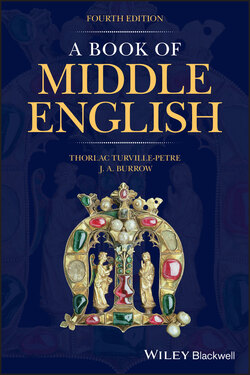Читать книгу A Book of Middle English - J. A. Burrow - Страница 30
4.2.3 Developments in Noun Inflexions
ОглавлениеThis diversity of forms was simplified from an early date in northern and eastern parts of the country. In the mid‐twelfth century The Peterborough Chronicle (text 1) has what is essentially the modern paradigm:
| sg. | nom./acc. | tun |
| gen. | tunes | |
| dat. | tun or tune | |
| pl. | (all cases) | tunes |
After prepositions the noun in the singular sometimes has the dative ‐e, but is as often uninflected, and in later texts the inflexion is dropped altogether except in a few phrases such as of his live (rhyming with bilive), 5/583, for soþe (rhyming with to þe), 9/415. The ‐es ending, often reduced to ‐s, becomes the general marker for the plural with few exceptions; the poems of the Gawain manuscript (represented by texts 8, 9 and 10) have yʒen, ‘eyes’, and oxen. A second plural ‐en was sometimes added to yʒen, giving yʒnen (ehnen, 4/13); and similarly with child, the plural childer 8/388 (OE cildru), usual in the North, has in the South the ‘double plural’ form children, 7a/65. The genitive plural ‐(e)ne still occasionally appears in forms such as lollarne, ‘of idlers’, 7a/31.
